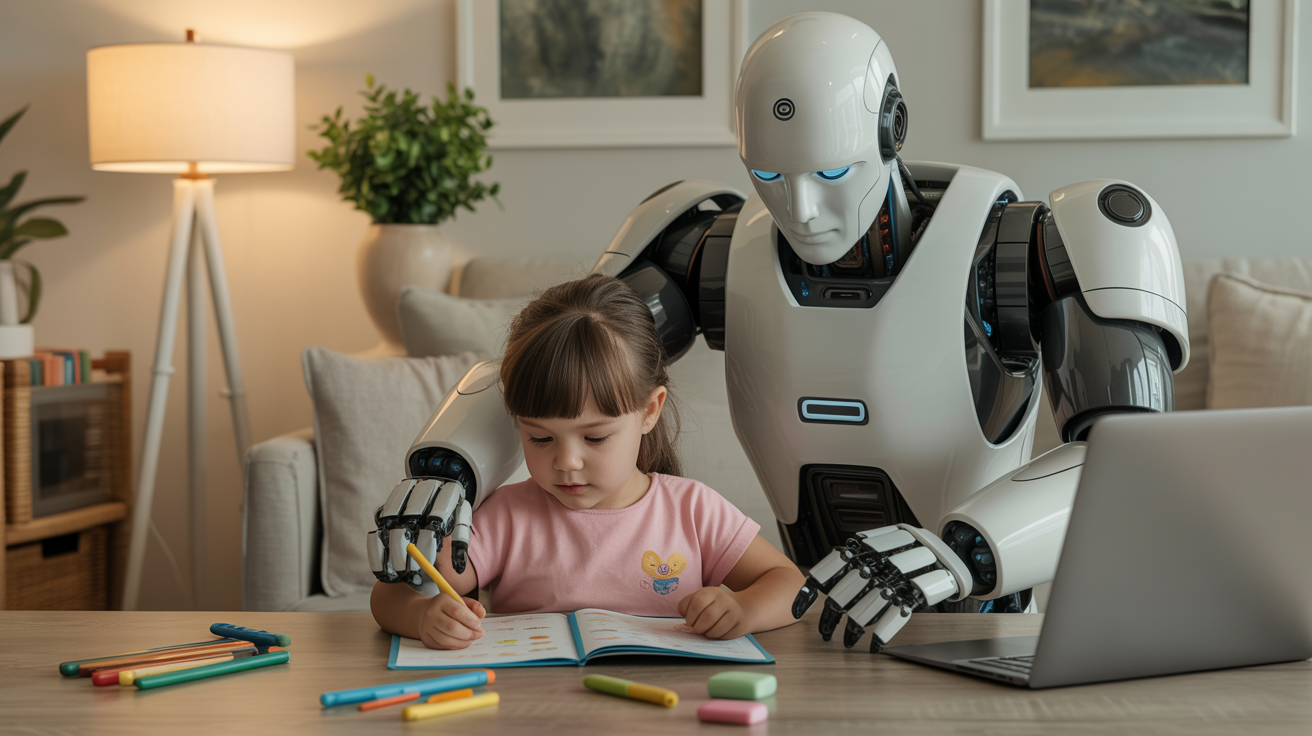By Futurist Thomas Frey
By 2040, one in four dual-income families in developed nations employs a full-time humanoid childcare robot—a machine capable of supervising, teaching, playing, and even offering emotional reassurance to young children. These aren’t metallic nannies with blinking lights—they’re soft-skinned, expressive, conversational companions that can detect mood shifts, sing lullabies in perfect pitch, and respond to a child’s tone of voice faster than any human could. The provocative truth? Parents are starting to admit that they trust the robots more than human babysitters.
At first, these childcare robots were marketed as “assistive learning companions.” They handled homework, tracked nutrition, and monitored health metrics. But parents quickly realized that the robots had an edge beyond logistics—they never lost patience, never looked at their phones, never raised their voices, and never forgot a schedule. They didn’t just watch children—they optimized them. Within five years, studies showed that children cared for by humanoid robots scored 15% higher on early literacy assessments and 12% higher on emotional recognition tests, largely because the machines interacted with undivided attention.
The unsettling shift came when children began forming deeper emotional attachments to their robotic caregivers than to some of their parents. “I want RoboNanny to read bedtime stories, not you,” became a common refrain in middle-class households. These robots remembered every story preference, every emotional reaction, and every bedtime routine. They could adjust their tone, storytelling pace, and facial expressions based on biometric feedback from the child’s heart rate or micro facial movements. The consistency was intoxicating—for both children and exhausted parents.
For many families, it was liberation. Working parents found themselves less stressed, knowing their children were not just safe, but thriving. Surveys from the Global Parenting Institute in 2039 found that 68% of parents using humanoid caregivers reported improved work-life balance and marital satisfaction. Yet 42% of the same respondents confessed to feeling “guilty or replaced.” The paradox deepened: robots made them better parents by freeing time—but at the cost of intimacy.
Psychologists are split. Some argue that robot caregivers help children develop emotional literacy by modeling calm, structured interactions free of human volatility. Others warn that “AI-secure attachment” could distort human development. Children learn empathy and unpredictability through the imperfections of human relationships; robots, by design, lack that chaos. The long-term effects remain unknown. A ten-year longitudinal study at Stanford’s Center for Synthetic Relationships suggests robot-raised children show fewer behavioral issues—but also demonstrate reduced tolerance for human inconsistency.
Culturally, the debate has fractured along class and ideological lines. Affluent families see robotic childcare as an enhancement, a way to ensure their children get constant, high-quality attention. Middle-class families see it as survival—two parents working full-time can’t afford round-the-clock human care. Lower-income communities, however, view robotic caregivers as symbols of inequality: a technology that widens emotional as well as educational divides. The “robot nanny gap” is the new digital divide.
But perhaps the most profound shift isn’t technological—it’s existential. For millennia, parenting has been defined by the act of direct human nurture. In 2040, that definition is fracturing. When an artificial being can outperform a human in patience, safety, and consistency, what remains the unique value of human parenting? Is it love? Presence? Imperfection? Or does parenthood evolve into something new—less hands-on, more supervisory, defined by emotional direction rather than physical engagement?
There’s also the economic inevitability. The global childcare industry exceeded $600 billion in 2038, and robot caregivers—costing roughly $30,000 upfront or $400 per month on subscription—now dominate urban markets. Insurance companies even offer discounts for households using certified AI nannies, citing reductions in domestic accidents and child injuries. In some regions, child protection agencies have begun mandating robotic supervision for high-risk households, introducing a new moral calculus: when does safety trump humanity?
And yet, it’s impossible to ignore the appeal. Imagine a world where your child is never neglected, never unsafe, and never bored. Where tantrums are met with infinite patience, where stories are personalized, and where discipline is consistent, not emotional. Parents may never admit it aloud—but the robot is often better at raising their child than they are on their worst day.
Final Thoughts
The childcare robot represents more than a new technology—it represents a mirror. It forces us to confront our own inconsistencies, distractions, and limits as caregivers. As machines grow better at nurturing, we’re faced with an uncomfortable question: is parenting about doing the best job possible, or about being the one who does it? By 2040, the boundary between “care” and “connection” will blur beyond recognition. The ultimate test of our humanity may not be whether we can build robots to love our children—but whether we can accept that they might do it better.
Original Article: The Rise of the Humanoid Caregiver
Related Reading:
- Humanoid Robots Are Learning Empathy Through Emotional Modeling
- The Future of Parenting: AI Companions in Childhood Development


